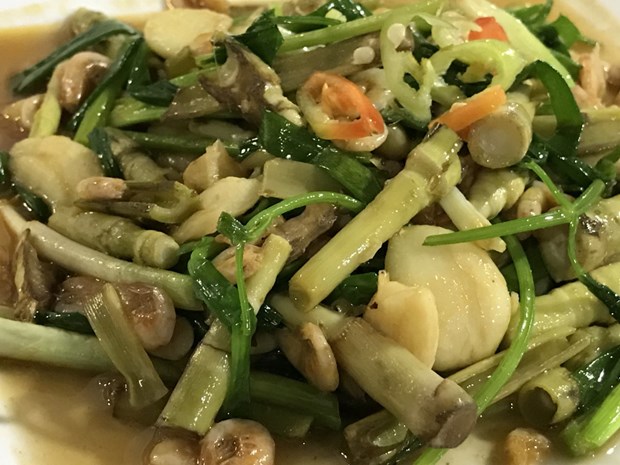
Stir-fried reed tips.
As
the majority of my age, I had known about reeds in middle school but never had
seen real ones.
I
got acquainted with reeds through a famous statement of a multi-field genius
Christian Blaise Pascal, “The human being is only a reed, the most feeble in
nature; but this is a thinking reed.”
The
invitation of romantic Can Tho province gave me a little more knowledge of
cuisine: the tips of reeds. Reeds and kan grass have been always mentioned
together so people have misunderstood about their origins. In fact, kan grass
has solid stems while reeds have hollowed stems.
An
average diameter of reed stems is around 1.5cm whereas kan grass’ is 2cm. The
very bottom part of kan-grass stems, called “sugar kan-grass”, is used to cook
herbal drinks. Reeds, in the other hand, are well known of their root. Oriental
medicine believes that reed roots can heal several types of illness while
Western science discovered the incredible usage of them. The ecosystem of reed
roots works as a natural water filter and works without expenses.
There
was a restaurant stuffing small fish into hollowed reed stems and grilling
them. The dish did bring an impressive vision and nose.
In
fact, reed bamboo shoot and tips are edible. Reed bamboo shoot is collected
right after a newborn reed emerging out of the ground, and tips are the
youngest part of stems, where begins to grow leaves.
In
that evening at the end of November, I was treated raw reed tips and pickled
ones.
Reed
tips has put in the list of Vietnamese side dish pickles, including bitter
melon, Xuoc Nuoc water grass (Centrostachys aquatica), figs, pineapple tips,
water hyacinth (Pontederiaceae), sliced banana trunk, onions, water taro
(Colocasia esculenta), and candle grass (Typha orientalis). Ms Hoa, a
restaurant owner, said that she wanted to make a full collection of 10 pickled
vegetables.
Raw
reed tips have a sour first-taste and a bit bitter after-taste. My old friend
Buu Viet told me the story of this rustic food.
Children
from years ago all knew reed tips as a free snack just for fun. Recently,
people have turned them to a formal dish.
The
day after, we did a fail-or-pass test on new dishes from reed tips. Which one
passes would be on official menu of the restaurant, and the dish was stir-fried
reed tips with tiny shrimps. Reed tips must be freshly harvested; otherwise
they will be fibrous.
Wonderful
taste! Not just sweetness, the dish definitely had “umami” - the smooth robust
flavor from rich ingredients. A diner said, “More reed tips and less shrimps
will be better.”
On
that dining table, a controversial story about plants’ tips blasted out. The
first common one was tips of coconut trees. Recently, this product has been
exploited much more than before so that farmers grow coconut trees just to
collect their tips instead of traditionally fruits collecting. However, that
type of mass production makes less quality since the coconut tips are not
mature enough to have sheaths.
Other
mentioned tips were from betel trees – which are much bitter and too crunchy,
and Dung Dinh trees (Caryota mitis) – which are extremely rare.
Therefore,
a new clean produce, reeds’ tips, has been brought in culinary world. Reeds are
now much more useful besides their craft usages.
By Ngu Yen/TTTG